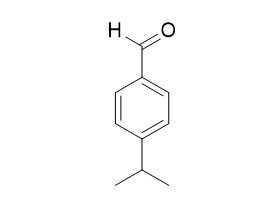4-Isopropylbenzaldehyde shows acetylcholinesterase (AChE) and butyrylcholinesterase (BChE) inhibitory activities. 4-Isopropylbenzaldehyde suppressed melanin formation in cultured murine B16-F10 melanoma cells in a dose-dependent decrease up to 0.25 mm without affecting cell growth.
Providing storage is as stated on the product vial and the vial is kept tightly sealed, the product can be stored for up to
24 months(2-8C).
Wherever possible, you should prepare and use solutions on the same day. However, if you need to make up stock solutions in advance, we recommend that you store the solution as aliquots in tightly sealed vials at -20C. Generally, these will be useable for up to two weeks. Before use, and prior to opening the vial we recommend that you allow your product to equilibrate to room temperature for at least 1 hour.
Need more advice on solubility, usage and handling? Please email to: service@chemfaces.com
The packaging of the product may have turned upside down during transportation, resulting in the natural compounds adhering to the neck or cap of the vial. take the vial out of its packaging and gently shake to let the compounds fall to the bottom of the vial. for liquid products, centrifuge at 200-500 RPM to gather the liquid at the bottom of the vial. try to avoid loss or contamination during handling.
Phytotherapy Research Ptr, 2010, 22(6):809-813.
Effects of cuminaldehyde on melanoma cells.[Pubmed:
18412105]
METHODS AND RESULTS:
Cuminaldehyde (4-Isopropylbenzaldehyde) suppressed melanin formation in cultured murine B16-F10 melanoma cells in a dose-dependent decrease up to 0.25 mm without affecting cell growth. Approximately 30% suppression in melanin production resulted when the cells were cultured with 0.25 mm of cuminaldehyde. This activity was not noticeable with cultured human A375 melanoma cells.
Ztschrift Fur Naturforschung C Journal of Bioences, 2008, 63(7-8):547-553.
Activity of essential oils and individual components against acetyl- and butyrylcholinesterase.[Reference:
WebLink]
METHODS AND RESULTS:
We have tested acetylcholinesterase (AChE) and butyrylcholinesterase (BChE) inhibitory activities of nineteen essential oils obtained from cultivated plants, namely one from Anethum graveolens L. (organic fertilizer), two from Foeniculum vulgare Mill. collected at fully-mature and flowering stages (organic fertilizer), two from Melissa officinalis L. (cultivated using organic and chemical fertilizers), two from Mentha piperita L. and M. spicata L. (organic fertilizer), two from Lavandula officinalis Chaix ex Villars (cultivated using organic and chemical fertilizers), two from Ocimum basilicum L. (green and purple-leaf varieties cultivated using only organic fertilizer), four from Origanum onites L., O. vulgare L., O. munitiflorum Hausskn., and O. majorana L. (cultivated using organic fertilizer), two from Salvia sclarea L. (organic and chemical fertilizers), one from S. officinalis L. (organic fertilizer), and one from Satureja cuneifolia Ten. (organic fertilizer) by a spectrophotometric method of Ellman using ELISA microplate-reader at 1 mg/ml concentration. In addition, a number of single components widely encountered in most of the essential oils [gamma-terpinene, 4-allyl anisole, (-)-carvone, dihydrocarvone, (-)-phencone, cuminyl alcohol, cumol, 4-Isopropylbenzaldehyde, trans-anethole, camphene, iso-borneol, (-)-borneol, L-bornyl acetate, 2-decanol, 2-heptanol, methyl-heptanol, farnesol, nerol, iso-pulegol, 1,8-cineole, citral, citronellal, citronellol, geraniol, linalool, alpha-pinene, beta-pinene, piperitone, iso-menthone, menthofurane, linalyl oxide, linalyl ester, geranyl ester, carvacrol, thymol, menthol, vanilline, and eugenol] was also screened for the same activity in the same manner.
CONCLUSIONS:
Almost all of the essential oils showed a very high inhibitory activity (over 80%) against both enzymes, whereas the single components were not as active as the essential oils.



